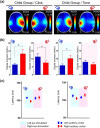Cortical hemispheric asymmetries are present at young ages and further develop into adolescence
- PMID: 29134751
- PMCID: PMC6866426
- DOI: 10.1002/hbm.23893
Cortical hemispheric asymmetries are present at young ages and further develop into adolescence
Abstract
Specialization of the auditory cortices for pure tone listening may develop with age. In adults, the right hemisphere dominates when listening to pure tones and music; we thus hypothesized that (a) asymmetric function between auditory cortices increases with age and (b) this development is specific to tonal rather than broadband/non-tonal stimuli. Cortical responses to tone-bursts and broadband click-trains were recorded by multichannel electroencephalography in young children (5.1 ± 0.8 years old) and adolescents (15.2 ± 1.7 years old) with normal hearing. Peak dipole moments indicating activity strength in right and left auditory cortices were calculated using the Time Restricted, Artefact and Coherence source Suppression (TRACS) beamformer. Monaural click-trains and tone-bursts in young children evoked a dominant response in the contralateral right cortex by left ear stimulation and, similarly, a contralateral left cortex response to click-trains in the right ear. Responses to tone-bursts in the right ear were more bilateral. In adolescents, peak activity dominated in the right cortex in most conditions (tone-bursts from either ear and to clicks from the left ear). Bilateral activity was evoked by right ear click stimulation. Thus, right hemispheric specialization for monaural tonal stimuli begins in children as young as 5 years of age and becomes more prominent by adolescence. These changes were marked by consistent dipole moments in the right auditory cortex with age in contrast to decreases in dipole activity in all other stimulus conditions. Together, the findings reveal increasingly asymmetric function for the two auditory cortices, potentially to support greater cortical specialization with development into adolescence.
Keywords: EEG; beamformer; development; evoked response; hemispheric specialization; right dominance; source localization; tonal sound.
© 2017 Wiley Periodicals, Inc.
Figures





References
-
- Ackermann, H. , Hertrich, I. , Mathiak, K. , & Lutzenberger, W. (2001). Contralaterality of cortical auditory processing at the level of the M50/M100 complex and the mismatch field: A whole‐head magnetoencephalography study. Neuroreport, 12, 1683–1687. - PubMed
-
- Aitkin, L. (1990). The auditory cortex: Structural and functional bases of auditory perception. Chapman & Hall.
-
- Belin, P. , Zilbovicius, M. , Crozier, S. , Thivard, L. , Fontaine, A. , Masure, M. C. , & Samson, Y. (1998). Lateralization of speech and auditory temporal processing. Journal of Cognitive Neuroscience, 10, 536–540. - PubMed
-
- Benjamini, Y. , & Hochberg, Y. (1995). Controlling the false discovery rate: A practical and powerful approach to multiple testing. Journal of the Royal Statistical Society. Series B (Methodological), 289–300.
Publication types
MeSH terms
Grants and funding
LinkOut - more resources
Full Text Sources
Other Literature Sources

